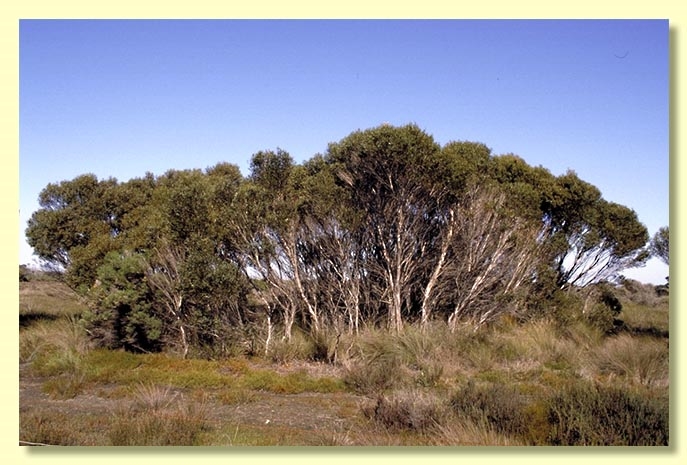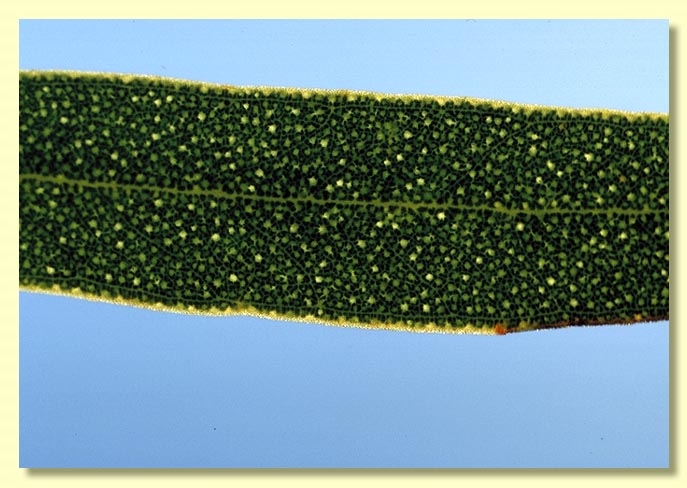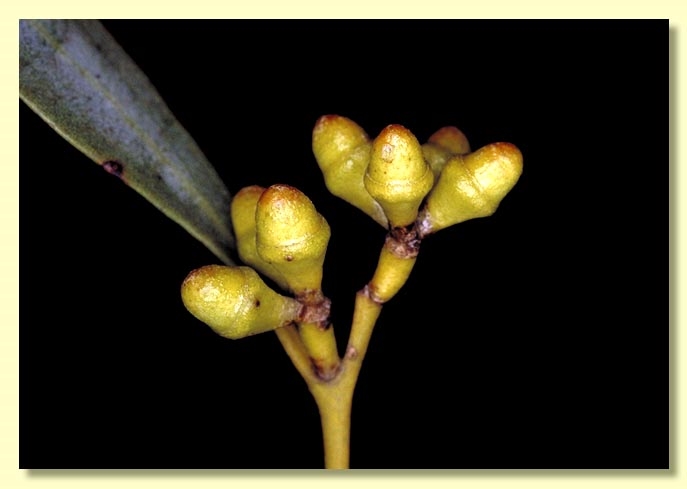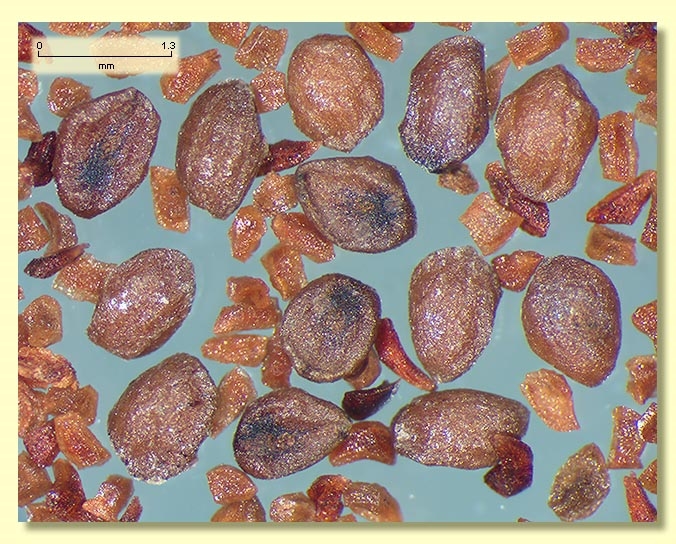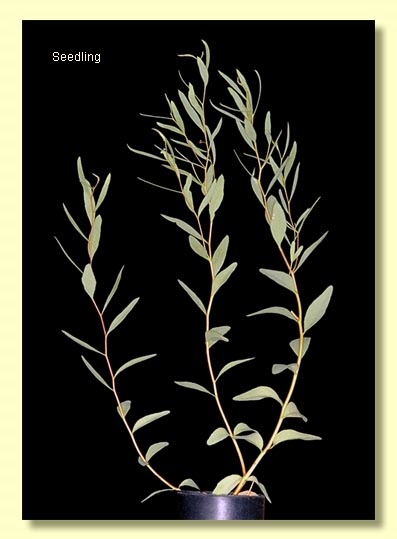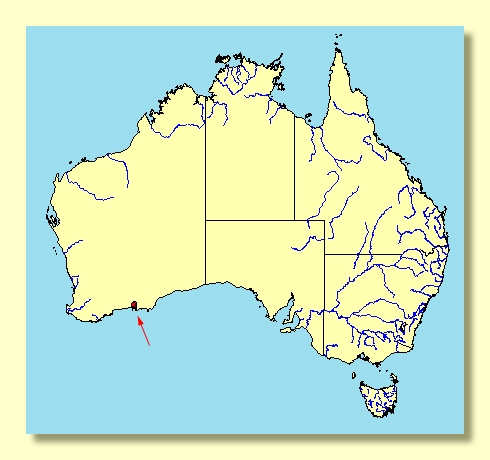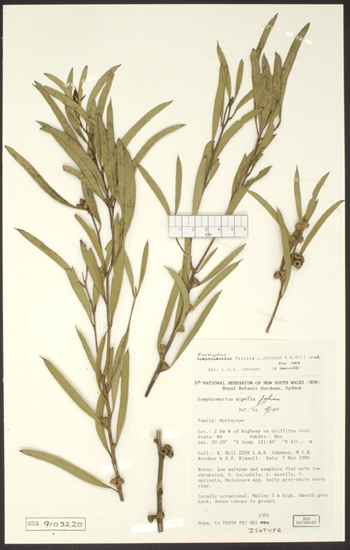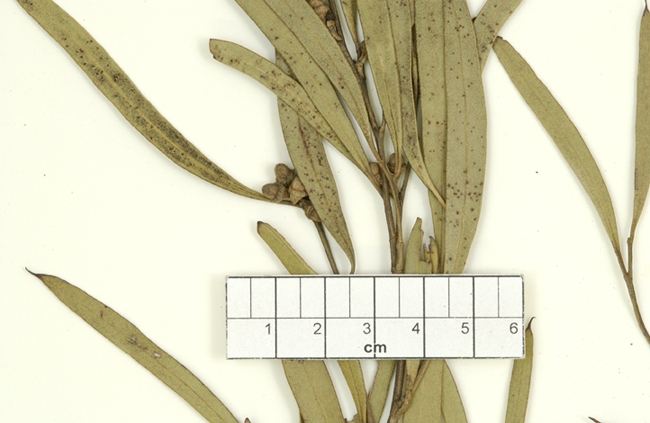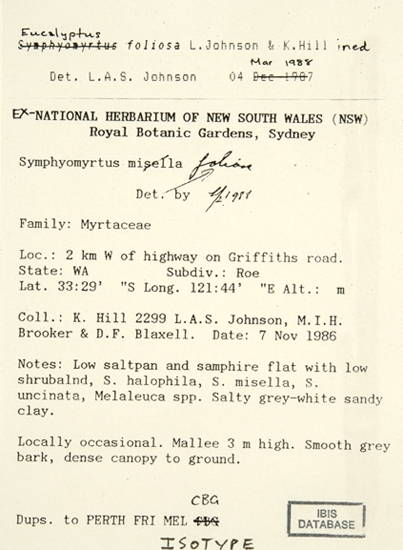Eucalyptus | Symphyomyrtus | Bisectae | Destitutae | Angustissimae | Oviformes
Euclid - Online edition
Eucalyptus foliosa
Bark wholly smooth, grey, grey-brown, rusty brown and greenish grey, ribbons sometimes present.
Branchlets lacking oil glands in the pith.
Juvenile growth (coppice or field seedlings to 50 cm): not seen.
Adult leaves held erect, alternate, petioles 0.3–0.8(1) cm long; blade narrowly oblong-elliptic to narrowly lanceolate or linear, 4.5–7.5 cm long, 0.5–1.1 cm wide, base tapering to petiole, margin entire, apex rounded-apiculate to pointed, concolorous, dull bluish green at first but soon maturing glossy green, side-veins greater than 45° to midrib, reticulation moderate to dense, intramarginal vein close to or remote from margin, oil glands numerous, mostly intersectional, ± round.
Inflorescence axillary, single, peduncles 0.2–0.6 cm long, buds 7 or 9 per umbel, pedicels 0.1–0.2 cm long. Mature buds ovoid (egg-in-eggcup) with hypanthium widest below join with operculum, 0.5 cm long, 0.35–0.4 cm wide, scar present, operculum usually rounded, stamens inflexed, anthers oblong to reniform, versatile, dorsifixed, dehiscing by short lateral slits, style long, straight, stigma blunt to rounded, locules 3, the placentae each with 4 vertical rows of ovules. Flowers white.
Fruit sessile or shortly pedicellate (pedicels 0.1–0.2 cm long), flattened-hemispherical to obconical and swollen, 0.4–0.5 cm long, 0.6–0.7 cm wide, disc level, valves 3, near rim level.
Seeds brown, 1–2.5 mm long, flattened-ovoid, dorsal surface ± smooth, sometimes furrowed, hilum ventral.
Cultivated seedlings (measured at ca node 10): cotyledons Y-shaped (bisected); stems rounded in cross-section, slightly warty or smooth; leaves linear and sessile to sub-sessile for ca 3 nodes, opposite until ca node 4–6 then alternate, becoming shortly petiolate, lanceolate-elliptic, 3.5–6 cm long, 0.5–1.7 cm wide, dull grey-green to green, thickish. By node ca 20 leaves are linear-elliptic.
Flowering time unknown.
A mallee endemic to Western Australia, found only in a small area just north of Esperance. It has smooth bark and a dense crown of dull to glossy green erect leaves.
In the classification of Brooker (2000) Eucalyptus foliosa belongs in Eucalyptus subgenus Symphyomyrtus section Bisectae subsection Destitutae because buds have two opercula, cotyledons are Y-shaped and branchlets lack oil glands in the pith. Within this subsection E. foliosa is closely related to only three other species, viz. E. angustissima, E. quaerenda and E. misella, together forming series Angustissimae, characterised by the erect leaves, egg-in-eggcup buds and stamens with more or less reniform anthers. Of these E. misella occurs away from salt lakes in heath vegetation on sand with gravel high in the profile, whilst E. foliosa, E. quaerenda and E. angustissima occur on white sands near salt lakes.
The four species are only weakly separated morphologically. E. foliosa has wider adult leaves than E. angustissima but has only slightly narrower leaves than E. misella. The habitats of E. foliosa and E. misella differ as stated above.
E. foliosa may be superficially confused with another mallee species found near salt lakes, E. halophila. That species differs in many ways, most obviously in having some basal rough bark, in the adult leaves where the great density of oil glands obscures the venation, in the buds where the outer stamens are infertile (staminodes) and in the seeds with their irregularly pitted seedcoat.

